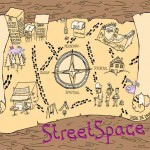I recently did a podcast for Youthscape which timed in well with a lot of thinking I have been doing recently about the nature of church. my amazing friend Paul Rose gave some great thoughts that’s set my mind going on why knowledge (epistemological) based approaches to defining church are such a stumbling block. I think much of what I was arguing for in Here Be Dragons was a more ontological approach but At the time I hadn’t really encountered enough embodied theology and practice to start to frame it well. As Rachel and Martin said I use a lot of long words I thought I might just explain the ontological approach a bit more here. And then I thought as it was youth focussed and I’m into co-creation why not use the latest tech to help. So I asked ChatGPT Ai to write it for me in the style of Sunday Papers blogpost and here with a few edits is what was created.
I think my shift reflects the growing interest among theologians and religious scholars in the use of an ontological approach and towards a deeper consideration of the fundamental nature of reality, and a rejection of the dualistic thinking that has long dominated Western thought. Part of what we learnt from being and doing church young people and Flow was we needed a different embedded joined up approach, and this was where we were heading in Here Be Dragons with sobornost.
At its heart, an ontological approach to the church emphasizes the importance of being and existence, rather than simply knowledge and understanding. While the epistemological approach tends to focus on the intellectual aspects of faith – what we know, what we believe, and how we come to know it – the ontological approach looks beyond these cognitive processes to consider the very nature of the church itself, and the role it plays in the world.
One of the key benefits of an ontological approach is that it allows us to move beyond the limitations of language and conceptual thinking. Too often, our understanding of the church is shaped by our attempts to put it into words – to define it, categorize it, and understand it within a particular framework. However, this can often lead to a narrow and limited understanding of what the church really is, and what it can be.
By adopting an ontological approach, we can begin to see the church as a dynamic, living entity that is constantly evolving and changing over time. Rather than trying to pin it down with definitions and concepts, we can appreciate the church in all its complexity, and recognize the many different ways in which it can manifest itself in the world.
Moreover, an ontological approach to the church allows us to move beyond the traditional boundaries of religious affiliation and denomination. Rather than seeing the church as a set of beliefs or practices that are unique to a particular group, we can recognize that the church exists in many different forms and contexts, and that it has the potential to transcend the divisions that often separate us.
Of course, an ontological approach is not without its challenges. It requires us to embrace uncertainty and ambiguity, and to acknowledge that our understanding of the church will always be limited by our own experiences and perspectives. However, these challenges are precisely what make the ontological approach so valuable – by embracing the unknown and the unknowable, we open ourselves up to a deeper and more meaningful relationship with the church, and with the divine.
In conclusion, the adoption of an ontological approach to the church represents an important step forward in our understanding of what it means to be religious and spiritual in the modern world. By focusing on being and existence, rather than simply knowledge and understanding, we can move beyond the limitations of language and conceptual thinking, and appreciate the church in all its complexity and diversity. So let us embrace this approach, and open ourselves up to a deeper and more profound experience of the divine.
The Ai bit ends here.
once the podcast goes fully live on the site I might say a bit more why I think how the epistemological approach showed up in the podcast discussion and how it can inoculate us from change.

